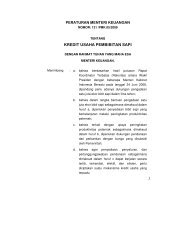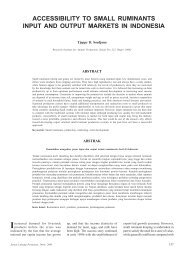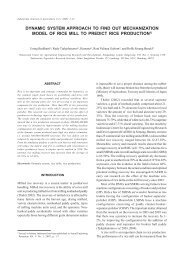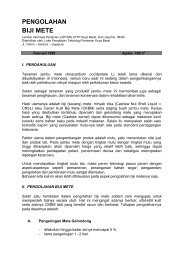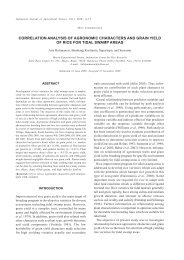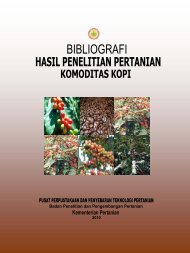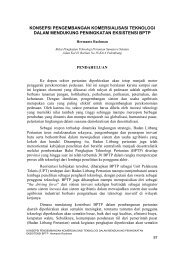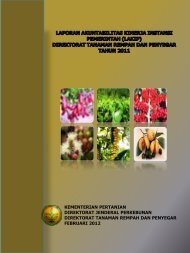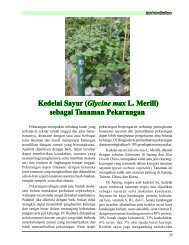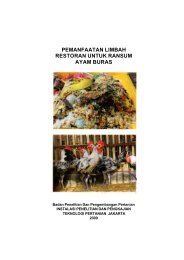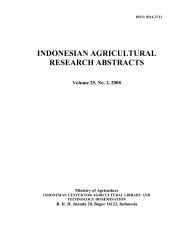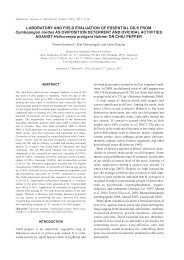major issues and challenges for improving the marketing
major issues and challenges for improving the marketing
major issues and challenges for improving the marketing
Create successful ePaper yourself
Turn your PDF publications into a flip-book with our unique Google optimized e-Paper software.
MAJOR ISSUES AND CHALLENGES FOR IMPROVING THEMARKETING AND DISTRIBUTION OF AGRICULTURALPRODUCTS 1Kaman NainggolanBureau of Planning <strong>and</strong> Finance, Ministry of Agriculture Republic of IndonesiaJl. Harsono RM No. 3 Ragunan Pasar Minggu, Jakarta Selatan 12550INTRODUCTIONThe world that we are facing today is characterized by rapid <strong>and</strong>fundamental change toward a new global economic change. Geopolitical change,which is not easily predictable as to its direction as well as its impact <strong>and</strong> <strong>the</strong>increasingly rapid development of science <strong>and</strong> technology are quickly driving <strong>the</strong>world economy into <strong>the</strong> era of globalization.Over <strong>the</strong> past three decades, <strong>the</strong> economy of globality has grownenormously. The successes of GATT, APEC <strong>and</strong> o<strong>the</strong>r regional economicdevelopment, principally, produce agreement on opening <strong>the</strong> market all over <strong>the</strong>world. The significant action to achieve free trade is to reduce, step by step, tariff<strong>and</strong> non-tariff barriers that is believed to be <strong>the</strong> trade barrier in <strong>the</strong> past worldtrade. We have witnessed acceleration of international financial flows <strong>and</strong> massivegrowth of <strong>for</strong>eign direct investment, fuelled by <strong>the</strong> opening of world markets, allcontributed to a significant expansion of <strong>the</strong> size of <strong>the</strong> global economy.To compete in <strong>the</strong> international market, certain quality of products has tomeet <strong>the</strong> requirements of <strong>the</strong> st<strong>and</strong>ardization systems, such as <strong>the</strong> series of ISO9000. There<strong>for</strong>e, production <strong>and</strong> <strong>marketing</strong> management quality should beimproved to con<strong>for</strong>m to international st<strong>and</strong>ards. World-class quality of productsincreases competitiveness <strong>and</strong> access to international markets. Accordingly, <strong>the</strong>agribusiness process should be market driven, in a sense that businessmen shouldproduce what <strong>the</strong> market wants ra<strong>the</strong>r than selling what <strong>the</strong>y can produce.CURRENT STATUS OF GLOBAL MARKET : OPPORTUNITY ANDCHALLENGEToday <strong>the</strong> global market is characterized by free flow of resources. Withregard to <strong>the</strong> markets <strong>the</strong>re are two fundamental revolutions: i) world markets areopening up, <strong>and</strong> ii) in<strong>for</strong>mation technology becomes pervasive.Twenty years ago half of <strong>the</strong> nations were closed to market economies.Today, perhaps less than 10 countries can still be considered to be closed. The1 Paper presented at <strong>the</strong> 'Seminar on Promoting Domestic <strong>and</strong> International Market <strong>for</strong> AgriculturalProducts' Asia Productivity Organization (APO) Seminar', 2-6 September 2002 Jogyakarta,Indonesia.MAJOR ISSUES AND CHALLENGES FOR IMPROVING THE MARKETING AND DISTRIBUTION OFAGRICULTURAL PRODUCTS Kaman Nainggolan25
People Republic of China that recently became <strong>the</strong> WTO member will make worldmarket more competitive. The opening of frontiers goes in parallel withharmonization of business rules worldwide thorough regional agreement <strong>and</strong>global agreement such as GATT. Similar opening of what used to be closedindustry such as telecom, <strong>and</strong> privatization also mirrors this trend. Theconsequences of this fundamental trend are: There are more business opportunities than ever, There are more competitors than ever, Nations, enterprises <strong>and</strong> people alike are more vulnerable than ever.OpportunityThe changing trends in global markets will affect agribusiness sector. Aswe are all aware, <strong>the</strong> basic role of agriculture remains important as a source offoodstuffs, supports agro-based indutry, <strong>and</strong> as a source of employment especiallyin developing countries. In a more open economy, <strong>the</strong> external sector becomesmore important <strong>and</strong> <strong>the</strong>re<strong>for</strong>e international <strong>marketing</strong> of agriculture products isextremely important. Trading of agricultural products is likely to continue toexp<strong>and</strong> in coming decades in response to rising populations <strong>and</strong> increasing fooddem<strong>and</strong>. A more open export markets in <strong>the</strong> future will provide marketopportunities especially <strong>for</strong> <strong>the</strong> countries with production surplus.According P<strong>and</strong>ey (1996) some of processed commodities such as sugar<strong>and</strong> oil, fruits <strong>and</strong> vegetables have a higher response to income changes than thatof basic staples. Similarly, Food <strong>and</strong> Agrocultural Organization (FAO) reveals that<strong>the</strong> processed products will dominate future dem<strong>and</strong> of agricultural products.Traditional commodities such as tropical products showed negligible growth,cereals <strong>and</strong> sugar showed negative growth, <strong>and</strong> vegetable oils showed moderategrowth. Table 1 shows <strong>the</strong> detail in<strong>for</strong>mation.Processed agricultural products do not only add <strong>the</strong> value but alsorelatively ease in trading since <strong>the</strong> processed product have less price fluctuations,easy to store, <strong>and</strong> last longer. In line with transparency in tariff policy, escalationtariff on processed product in international markets will be reduced in <strong>the</strong> future,increasing <strong>the</strong>ir market opportunities.The above table reveals that in <strong>the</strong> world markets, processed foodsindicated <strong>the</strong> most rapid growth. World markets <strong>for</strong> <strong>the</strong> traditional exports ofASEAN countries have been particularly weak. World exports of tropical productsgrew by only 1.7 percent per annum over <strong>the</strong> past decade. The growth rate ofvegetable oils has been somewhat higher at 4.8 percent per annum. Meanwhile,world trade in higher valued products such as meats, fruits <strong>and</strong> vegetables, fishproducts, <strong>and</strong> o<strong>the</strong>r processed products has been far more dynamic. Growth rates<strong>for</strong> many products have exceeded 10 percent per annum over <strong>the</strong> past decade. Thisreflects <strong>the</strong> high growth rates of many emerging markets <strong>and</strong> high-incomeelasticity of dem<strong>and</strong> <strong>for</strong> higher valued products, including processed foods.AKP. Volume 2 No. 1, Maret 2004 : 25-3626
Table 1. World Markets <strong>for</strong> Agricultural CommoditiesCommodityTraditional- Tropical products *of which rubber- Cereals- Sugar- Vegetables oils *)Market descriptionNegligible growthNegligible growhNegative growthNegative growthModerate growthGrowth rate(percent per annum)+ 1.7+ 0.4- 0.5- 1.5+ 4.8Non traditional- Fruits <strong>and</strong> vegetables *)- Meats- Fish product *)- Beverages, tobacco, &processed foods *)Source:Rapid growthModerate growthRapid growthRapid growth+ 10.1+ 6.6+ 10.8+ 11.5FAO in Magiera (1995). With <strong>the</strong> exception of <strong>the</strong> items with asterisk, All growth iscompounded over <strong>the</strong> years 1983 to 1993.For items with asterisk, growth rates are compounded over <strong>the</strong> years 1983 to 1991Although in <strong>the</strong> future international markets may be more in <strong>the</strong> <strong>for</strong>m ofprocessed products, dem<strong>and</strong> <strong>for</strong> fresh food products remains high especially in <strong>the</strong>Japanese markets. Given this situation, developing a system of packaging thatretains <strong>the</strong> quality of <strong>the</strong> products meeting with <strong>the</strong> taste <strong>and</strong> high st<strong>and</strong>ardsrequired are absolutely necessary. Japan <strong>for</strong> instance, usually applies threedomestic laws regarding imported foods. Food Safety Law basically covers <strong>the</strong>maximum content of edible chemical allowed such as additives or sweetener, <strong>and</strong>maximum content of pesticide residues allowed etc. Plant Protection Law appliessanitary <strong>and</strong> phytosanitary requirements, <strong>and</strong> Food Control Law requires that allimported foods must have such a label in<strong>for</strong>ming <strong>the</strong> nutrition content, completeaddresses of <strong>the</strong> manufactures/producers <strong>and</strong> <strong>the</strong> local importer.The European Union also applies stricter regulations on quality st<strong>and</strong>ards,sanitary <strong>and</strong> veterinary controls <strong>for</strong> importing fishery products. The EuropeanUnion, which has just ratified its agricultural re<strong>for</strong>m (Common Agriculture Policy)will open <strong>the</strong>ir market <strong>for</strong> organic <strong>and</strong> 'free pesticide' products. Organic farmingwill be more intensified in European Union. The impact needs to be anticipatedare controlling on <strong>the</strong> usage of preservatives, hormones, antibiotics, <strong>and</strong>pesticides. Market opportunity <strong>for</strong> organic foods will rise in accordance withincreasing dem<strong>and</strong> <strong>for</strong> natural foods.In Japan, dem<strong>and</strong> <strong>for</strong> frozen vegetables <strong>and</strong> processed fish tend toincrease. Dem<strong>and</strong> <strong>for</strong> frozen vegetables has increased from 430,000 tons in 1993to 700,000 tons in 1998. Most of vegetables dem<strong>and</strong>ed by Japanese market can begrown in many countries like egg plant, Chinese cabbage, okra, melon, cucumber,paprika etc.--an opportunity to increase export earnings. Similarly, import <strong>for</strong>MAJOR ISSUES AND CHALLENGES FOR IMPROVING THE MARKETING AND DISTRIBUTION OFAGRICULTURAL PRODUCTS Kaman Nainggolan27
fresh <strong>and</strong> frozen fruits increase sharply in Japan. Fruit imports are mostly in frozen<strong>for</strong>m due to strict requirements <strong>for</strong> quarantine <strong>and</strong> food safety law. Indonesianexport share in Japan is still very low.In 1992 Indonesia was <strong>the</strong> leading shrimp exporter to Japan with a marketshare of 21 percent. However, dem<strong>and</strong> <strong>for</strong> frozen shrimp is projected to decreasein <strong>the</strong> next 3 years. According to Sanwa Research Institute (2000), frozen shrimpmarket is saturating, <strong>and</strong> dem<strong>and</strong> <strong>for</strong> processed products such as hot <strong>and</strong> spicy fishtend to increase especially <strong>for</strong> youngsters. Again, market opportunity is widelyopen but in a different <strong>for</strong>m, much different than it was 10 years ago.How about United States? Fish import into USA is predicted to increase<strong>for</strong> <strong>the</strong> next 3 years. By value, US shrimp import was 4.38 percent in <strong>the</strong> last 5years. Main supplier was Thail<strong>and</strong> with 34% share, while Indonesia's share wasonly 5%. Import bill of USA <strong>for</strong> shrimp was US $ 3.1 billions in 1998. For tuna,USA is <strong>the</strong> second largest importer after Japan with annual import rangingbetween 240,000-250,000 tons. Indonesian tuna export was 14,000 tons in 1998.The leading supplier is Thail<strong>and</strong> followed by <strong>the</strong> Philippines.Currently, USA tends to import more tropical products because of strongdollar relative to Asian currencies. Indonesia <strong>for</strong> instance, is <strong>the</strong> second largestexporter of cocoa beans to <strong>the</strong> USA after Ivory Coast. The problem with <strong>the</strong> USAmarket is that it tends to impose more strict requirements than that of internationalst<strong>and</strong>ard such as Codex Alimentarius- a condition legalized by <strong>the</strong> World TradeOrganization (WTO). Many Indonesian export products are still subject todetention imposed by <strong>the</strong> USA such as shrimp, tuna, fish fillet, cocoa beans,mushroom <strong>and</strong> can pineapple.The Uruguay Round Agreement will open products markets in <strong>the</strong>developed countries applying high protection <strong>for</strong> <strong>the</strong>ir agriculture practicesfacilitated by <strong>the</strong> "minimum access" that should be applied. This will be ano<strong>the</strong>rchallenge <strong>for</strong> developing countries to enhance <strong>the</strong>ir share in <strong>the</strong> global market ofagricultural products. However, o<strong>the</strong>r constraints may arise especially in <strong>the</strong> <strong>for</strong>mof disguise export subsidies <strong>and</strong> domestic supports which so far have been heavilypracticed by some countries (developed countries <strong>the</strong> most).ASEAN countries have not traditionally exported high valued foodcommodities, but Thail<strong>and</strong> has become a successful exporter processed fruits,vegetables <strong>and</strong> fish product. It also exports poultry products <strong>and</strong> leads in <strong>the</strong>export of fresh tropical fruits.To accommodate this opportunity, a strong <strong>and</strong> effective food processing<strong>and</strong> o<strong>the</strong>r agro-based industries sectors are considered to be important <strong>for</strong>diversification <strong>and</strong> commercialization of agriculture, <strong>improving</strong> rural income <strong>and</strong>employment, value addition <strong>and</strong> generation of surplus <strong>for</strong> export, reducing wasteof perishable products, as well as foster rural industrialization. The governmentshould provide massive thrusts <strong>and</strong> act as a catalyst <strong>for</strong> getting investments intoagribusiness including food processing sector, encouraging export <strong>and</strong> creating aAKP. Volume 2 No. 1, Maret 2004 : 25-3628
general atmosphere <strong>for</strong> a healthy growth of <strong>the</strong> food processing <strong>and</strong> agro-basedindustry. Private initiative should be continuously encouraged to undertake thisrole which <strong>the</strong> government plays as a facilitator, motivator <strong>and</strong> regulator <strong>for</strong>investment <strong>and</strong> growth.ChallengesAlthough global market offers business opportunity. various <strong>for</strong>eign traderegulations are still imposed variously among <strong>the</strong> countries. In addition to <strong>the</strong>international treaties <strong>and</strong> agreements governing international trade such as WTO,general regulations are applied dealing with customs, tariffs, banking or <strong>for</strong>eigntrade control, unjustified competition, anti dumping <strong>and</strong> anti trust. For agriculturalproducts, additional regulations are usually applied such as laws on foodsanitation, sanitary-phytosanitary, <strong>and</strong> food control. Some countries also applyCITES, well known as Washington Agreement i.e. Convention on InternationalTrade in Endangered Species of Wild Fauna <strong>and</strong> Flora. For fishery products in <strong>the</strong>United States, imported commodities should also honor <strong>the</strong> Marine MammalsProtection Act, Dolphin Safe treatments, <strong>and</strong> Environmental Protection Law.Guarantee on product quality is not only based on final products but alsoon <strong>the</strong> whole process of production. ISO st<strong>and</strong>ards, FAO/WHO CodexAlimentarius st<strong>and</strong>ards, <strong>and</strong> Hazard Analysis Critical Control Point (HACCP) are<strong>the</strong> common requirements in <strong>the</strong> current global trade signaling <strong>the</strong> era of qualityrevolution.Japan requires imported agricultural products meet with <strong>the</strong> JapanAgricultural St<strong>and</strong>ards (JAS) applying to beverages, processed foods, <strong>for</strong>estproducts, agricultural commodities, livestock products, oils <strong>and</strong> fats, products offishing industry, <strong>and</strong> processed goods made from agricultural, <strong>for</strong>estry, <strong>and</strong> fishingraw materials. European Union requires specific containers to carry food products.The US market applies HACCP treatment <strong>for</strong> imported foodstuffs. Thisrequirement is regulated within <strong>the</strong> Uruguay Round on Technical Barrier to Trade<strong>and</strong> Sanitary <strong>and</strong> Phytosanitary Agreement, so that integrated quality improvementpattern is absolutely required to compete in <strong>the</strong> international markets.As discussed be<strong>for</strong>e, agribusiness development has a very promisingprospect in <strong>the</strong> future. However, competition will also be more severe to share <strong>the</strong>existing business opportunity (Table 2). To compete with o<strong>the</strong>r countries, ourexport commodities must have good competitive advantages. So far, commoditieswith comparative <strong>and</strong> competitive advantages are produced from <strong>the</strong> activitiescharacterized by <strong>the</strong> combination of resource base <strong>and</strong> low-wage labor ra<strong>the</strong>r thanthat of technological base or capital base.Characteristics of <strong>the</strong> market might also shift toward buyers market, <strong>and</strong><strong>the</strong>re<strong>for</strong>e, consumer bargaining power becomes stronger. In this situation,efficiency <strong>and</strong> competitive advantages appear to be more important. BusinessMAJOR ISSUES AND CHALLENGES FOR IMPROVING THE MARKETING AND DISTRIBUTION OFAGRICULTURAL PRODUCTS Kaman Nainggolan29
competition spreads to various aspects, <strong>and</strong> every enterprise tries to win businesscompetition. Up to 1970's, enterprises generally adopted four <strong>marketing</strong> mix i.efour P'S : price, place, product, <strong>and</strong> promotion to gain advantages. Commencing in1980's an additional P, 'that is power' was introduced, which was actually relatedto monopoly power, or "br<strong>and</strong> name", or "identity <strong>and</strong> image", owned by <strong>the</strong>enterprises.Since 1990's, <strong>the</strong> five P-<strong>for</strong>mula became irrelevant <strong>and</strong> insufficient, as <strong>the</strong>enterprises have to use four-R <strong>for</strong>mula i.e Right Product (R.1), Right Place (R-2),Right Price (R-3) <strong>and</strong> Right Time (R-4) to dominate <strong>the</strong> international market. It isnoted that R-4 is <strong>the</strong> most difficult to implement, because <strong>the</strong> right time here isfrom <strong>the</strong> point of view of consumers <strong>and</strong> is not that of producers. Right Time (R-4) also implies a dynamic element of agribusiness, which includes continuity ofproduction.The element of Right Product (R-1) implies that product characteristicsmust con<strong>for</strong>m to consumer preferences. Well-educated consumers will putemphasize on <strong>the</strong> importance of nutritional value <strong>and</strong> hygiene. The element ofRight Place (R-2) means that we have to identify <strong>the</strong> right market segment towhich our product has greater chance to be accepted. For example, youngprofessional in urban areas is a potential market segment <strong>for</strong> fresh fruit <strong>and</strong>vegetables, which can be penetrated through supermarket chain. The Right Price(R-3) involves pricing strategy, <strong>and</strong> usually price leader is a common strategy topenetrate <strong>the</strong> market.For Asia Pacific products to compete in international market, it has torespond to <strong>the</strong> future <strong>challenges</strong>:a. Superior quality. This is <strong>the</strong> most difficult to fulfill. Many countries nowimpose Sanitary <strong>and</strong> Phytosanitary Measures. Japan enacts 3 measures <strong>for</strong> itsagricultural imports: Japan Agriculture St<strong>and</strong>ard (JAS), Food Safety Law(FSL), <strong>and</strong> Plant Protection Law (PPL). United States imposes HazardAnalysis Critical Control Point (HACCP), Australia applies similar st<strong>and</strong>ard.b. Anticipation of market trends. Consumer preferences change dynamically.A more environment friendly <strong>and</strong> processed products will dominate market in<strong>the</strong> future.c. Superior market distribution. Exporters must develop market distributionabroad by establishing cooperation with <strong>for</strong>eign company. Efficientdistribution system will ensure on time delivery from producers to customers.Farmer groups can build <strong>the</strong>ir own distribution system with <strong>the</strong> support fromgovernment, or do contract with processors. The agribusiness terminal that isintroduced in Indonesia can facilitate farmers in distribution.d. Product Development. The product life cycle tends to be shorter. When <strong>the</strong>product reach saturation point, new product must be developed to meetconsumer satisfaction <strong>and</strong> maintain market share.MAJOR ISSUES AND CHALLENGES FOR IMPROVING THE MARKETING AND DISTRIBUTION OFAGRICULTURAL PRODUCTS Kaman Nainggolan31
e. Promotion. This is an important element commonly neglected by ourentrepreneurs. The Kiwi story is a good example of <strong>the</strong> importance ofpromotion.f. Continuity of Supply. Maintaining a continue supply is crucial in order toprovide goodwill to <strong>the</strong> customers.g. Market Research <strong>and</strong> Market In<strong>for</strong>mation System. Market research <strong>and</strong>in<strong>for</strong>mation is essential to analyze consumer preferences <strong>and</strong> competitors.Market in<strong>for</strong>mation is necessary to penetrate market. With <strong>the</strong> advance ofin<strong>for</strong>mation technology, enterprises can easily develop an on-line <strong>marketing</strong>in<strong>for</strong>mation system. Ministry of Agriculture has developed an on-line marketin<strong>for</strong>mation system to assist agribusiness in <strong>marketing</strong>. The site can beaccessed through http://www.fintrac.com/indoag/To answer <strong>the</strong> future <strong>challenges</strong>, countries must show positive responsesto increase competitiveness by <strong>improving</strong> productivity, efficiency <strong>and</strong> produceworld-class quality products, with continuous supply. In <strong>the</strong> era of globalization,consumer preferences will determine what to produce. This means that we have toconcentrate our attention on all sub-systems of agribusiness.A series of improvement programs to produce superior products withgood <strong>marketing</strong> prospect, meet market st<strong>and</strong>ard, <strong>and</strong> continuously supplied at acompetitive price. This requires a long period of adjustments. By next year,Sou<strong>the</strong>ast Asian countries have to face AFTA. Thereafter, in 2005, developingcountries have to have self-adjustment to be in <strong>the</strong> framework of WTO, <strong>and</strong> in2020 to that of APEC. So, within less than two year, we have to finalize <strong>the</strong>programs on increasing <strong>the</strong> competitiveness of our country (macro) <strong>and</strong> <strong>the</strong>competitiveness of our business (micro).AKP. Volume 2 No. 1, Maret 2004 : 25-3632MAJOR ISSUES IN AGRICULTURAL MARKETINGAs discussed previously, a more open international market offer greateropportunity <strong>and</strong> <strong>challenges</strong>. Agricultural <strong>marketing</strong> relates to export <strong>and</strong> domesticmarkets. However, ef<strong>for</strong>ts to penetrate export markets are much more difficultcompare with domestic markets <strong>and</strong> <strong>the</strong>re<strong>for</strong>e <strong>the</strong> following discussion will focuson export markets. Exporters, especially in developing countries are still facingsome external <strong>and</strong> internal problems. Below is <strong>the</strong> list of problems facing bydomestic exporters:a. International Trade BarriersExtremely strict import regulations imposed by some developed countriespose difficulty to enter <strong>the</strong> market. This <strong>for</strong>m of new protectionism which islegalized by <strong>the</strong> GATT/WTO is implemented through HACCP or sanitary <strong>and</strong>phytosanitary measures. Bilateral approach is needed to resolve <strong>the</strong> problem.Not many companies really underst<strong>and</strong> regulations imposed in WTO, so thatgovernment must conduct training <strong>for</strong> <strong>the</strong>se companies.
. Macro policy: credit availability, high interest rate, <strong>and</strong> fluctuating exchangerateSince <strong>the</strong> deep crisis hit many Asian countries, credit became scarcecombining with high interest rate. Many opportunities could not be realizedbecause of lacking of working capital particularly faced by small enterprises.Developing financial institution <strong>for</strong> SMEs would alleviate <strong>the</strong> problem. Thisproblem is exaggerated by fluctuating exchange rate, making exportersdifficult to plan.c. Trade Policy: export tax, import tax <strong>for</strong> raw materialsSome Indonesian competitive products are still confronted by export tax.Crude Palm Oil (CPO), rattan, <strong>and</strong> log <strong>for</strong> example are subject to export tax,which lower profit received by farmers. Export tax must be ended. On <strong>the</strong>o<strong>the</strong>r h<strong>and</strong> import tariff <strong>for</strong> some input required by farmers <strong>and</strong> <strong>for</strong> foodprocessing are still applied.d. Red Tapes PracticesIn some countries, Illegal retribution fees are still charged by governmentofficials (Retribusi Pungutan Hasil Pertanian – in Indonesian case).e. High Transport CostsShipping cost using domestic company <strong>for</strong> export is much higher comparedwith that abroad (<strong>for</strong> example Taiwanese ship is cheaper). Domestic shippingcompanies sometimes practices hidden surchargesf. Raw Materials with Good Quality <strong>and</strong> Continue SupplyLack of knowledge <strong>and</strong> seasonally is a critical factor here. Asia Pacificagriculture, except USA is characterized by small scale. It is difficult tomaintain a homogenous quality. Partnership between exporters <strong>and</strong> farmersshould be encouraged to overcome <strong>the</strong> problem. Unlike o<strong>the</strong>r industries,agroprocessing depends on a regular supply of high quality raw materials.g. Lack of Supporting FacilityAmong <strong>the</strong> most important is cooling storage <strong>the</strong> shipping ports, <strong>and</strong> irrigationin <strong>the</strong> farm fields. The idea of developing agribusiness terminals in productioncenters could also help overcoming <strong>the</strong> export <strong>and</strong> domestic problems.Agribusiness terminal is also function as a distribution network.h. Insufficient Distribution SystemDistribution system is very crucial in connecting farm produce to customercenters. Poor distribution system is common in almost all developingcountries. The idea of building wholesale markets in large cities, <strong>and</strong> terminalsin production areas will facilitate distribution, reduce post harvest loss, <strong>and</strong>improve bargaining position of farmers. Government may provide subsidy toinitiate <strong>the</strong> idea.i. Lack of Professional ManagersTo penetrate international market exporting company would need professionalmanagers. A rigorous knowledge of international market, regulation,MAJOR ISSUES AND CHALLENGES FOR IMPROVING THE MARKETING AND DISTRIBUTION OFAGRICULTURAL PRODUCTS Kaman Nainggolan33
Some agroprocessors lack strategic in<strong>for</strong>mation on international marketconditions <strong>and</strong> prices. This makes it more difficult <strong>for</strong> <strong>the</strong>m to negotiatefavorable prices with international brokers. Data banks on overseas prices <strong>for</strong>some commodities are now available through international reporting services.The Government should review <strong>the</strong>se data banks <strong>and</strong> determine whe<strong>the</strong>r itwould be worthwhile to make this in<strong>for</strong>mation available to agribusiness on afee-<strong>for</strong>-service basis.Few, if any, agribusinesses seem to know <strong>the</strong> implications of <strong>the</strong> UruguayRound <strong>for</strong> <strong>the</strong>ir commodities. Yet, <strong>the</strong> Uruguay Round could have a <strong>major</strong>impact on future market trends, <strong>and</strong> a list of all Uruguay Round countrycommitments is now available. Government officials need to learn how tointerpret <strong>the</strong>se commitments. The in<strong>for</strong>mation should <strong>the</strong>n be summarized <strong>and</strong>disseminated to <strong>the</strong> public.The Government needs to review current mechanism <strong>for</strong> relaying in<strong>for</strong>mationon product st<strong>and</strong>ards to processors. Agroprocessors generally rely on <strong>the</strong>irbuyers or joint venture partners <strong>for</strong> in<strong>for</strong>mation on <strong>the</strong> processing techniquesneeded to meet st<strong>and</strong>ards in export markets. However, this in<strong>for</strong>mation isgenerally not available <strong>for</strong> alternative markets, <strong>and</strong> changes in st<strong>and</strong>ards aresometimes relayed to processors after production runs are already in progress.This can lead to large losses.Tariff schedules <strong>for</strong> most of export markets are apparently available on CDroom.The Government could review this in<strong>for</strong>mation <strong>and</strong> examine <strong>the</strong>feasibility of making this data available to <strong>the</strong> public on a fee-<strong>for</strong>-servicebasis.Many non-tariff barriers (NTBs) remain on commodities of export interestto many developing countries (e.g. canned pineapples in Japan, canned tuna<strong>and</strong> mushrooms in <strong>the</strong> European Union, automatic detention <strong>for</strong> someproducts in <strong>the</strong> USA). A full list of <strong>the</strong>se barriers should be compiled <strong>and</strong>made available to senior Government officials. All NTBs should be reviewed<strong>for</strong> <strong>the</strong>ir legality under <strong>the</strong> GATT. When found to be of questionable legality,<strong>the</strong> Government should vigorously pursue GATT mechanisms to have <strong>the</strong>mremoved.InfrastructureThe Government should conduct a comprehensive review of plannedinvestment in ports <strong>and</strong> o<strong>the</strong>r infrastructure such as farm roads, agribusinessterminals, with a view towards exp<strong>and</strong>ing investment considerably. Improvedinfrastructure could be <strong>the</strong> single most important factor leading to improvedexpolts of agroindustrial products. In practice, publicly provided infrastructureservices have often delivered poor quality <strong>and</strong> inadequate coverage. Governmentshould increase private sector provision through regulatory re<strong>for</strong>m to increaseproductivity. However, some companies report transportation costs that were asMAJOR ISSUES AND CHALLENGES FOR IMPROVING THE MARKETING AND DISTRIBUTION OFAGRICULTURAL PRODUCTS Kaman Nainggolan35



